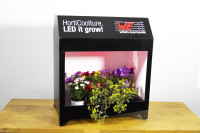Horticulture Box [180583]

Make your plants grow better thanks to special horticulture LEDs.
The research into and the use of artificial electric light sources to stimulate plant growth dates back to the second half of the 19th century. It closely followed the development of human electric lighting, which can roughly be divided into three paths of development: incandescent, open arc and enclosed gas discharge lamps. And of course: LEDs nowadays are also used for horticultural purposes.
The theory behind grow lights is far more complex than one would imagine and it is beyond the scope of this article to dive too deep into this matter, some excellent articles on this subject can be found in application notes ANO002 to ANO004 on Würth’s website. We will briefly highlight the most important advantages of LEDs in horticulture over their more conventional predecessors.
Most important is to know that not only the intensity, but also the spectrum of the light is of importance for the growth and development of plants. Here are some bandwidths and their known effects:
As opposed to older light sources, LEDs can be manufactured to emit very specific bandwidths of light, which allows us to tune the spectrum of a grow light (containing different colours of LEDs) to the needs of a plant. Würth Elektronik offers the WL-SMDC SMD Mono-color Ceramic LED Waterclear range of LEDs. The WL-SMDC range has been expanded to include wavelengths of 450 nm (Deep Blue), 660 nm (Hyper Red) and 730 nm (Far Red), which have been selected to match the absorption spectra of photosynthetic pigments. These three colors of LEDs are present in our grow light, together with some cool white (6000K) LEDs.
The ESP32 in our horticulture box has its own web-interface on which you can adjust the intensity level of every one of four channels independently, or adjust the overall intensity of the four channels via WiFi using your computer, smart phone or tablet.
The theory behind grow lights is far more complex than one would imagine and it is beyond the scope of this article to dive too deep into this matter, some excellent articles on this subject can be found in application notes ANO002 to ANO004 on Würth’s website. We will briefly highlight the most important advantages of LEDs in horticulture over their more conventional predecessors.
Most important is to know that not only the intensity, but also the spectrum of the light is of importance for the growth and development of plants. Here are some bandwidths and their known effects:
- Red light (630 – 660 nm) is the main driver of photosynthesis and is essential for the growth of stems. This wavelength also regulates flowering, dormancy and seed germination.
- Blue light (400 – 520 nm) is another key wavelength for photosynthesis but must be carefully controlled and mixed with other frequencies as over exposure at this wavelength may inhibit growth. This wavelength has also been linked to the regulation of chlorophyll concentration, lateral bud growth and leaf thickness.
- Far red light (720 – 740 nm) which is in the IR spectrum, influences germination and can reduce the flowering time of plants but also increase stem length, again as part of the “shade avoidance response”.
- Green light (500 – 600 nm) was once disregarded as being unimportant to plant development, but recent investigations have revealed that plants in the shade of others are particularly responsive to this wavelength as part of the “shade avoidance response”.
- UV light (280 – 400 nm) is still highly experimental in the cultivation of plants. Although this wavelength is mutagenic, some plants (e.g. lettuce, tomato) are much more resistant to these wavelengths. Studies suggest that these wavelengths can be used as fungal control on insensitive species. Additionally, UV light may be responsible for the generation of certain protective molecules like anti-oxidants and phenols, which are important for human nutrition.
As opposed to older light sources, LEDs can be manufactured to emit very specific bandwidths of light, which allows us to tune the spectrum of a grow light (containing different colours of LEDs) to the needs of a plant. Würth Elektronik offers the WL-SMDC SMD Mono-color Ceramic LED Waterclear range of LEDs. The WL-SMDC range has been expanded to include wavelengths of 450 nm (Deep Blue), 660 nm (Hyper Red) and 730 nm (Far Red), which have been selected to match the absorption spectra of photosynthetic pigments. These three colors of LEDs are present in our grow light, together with some cool white (6000K) LEDs.
The ESP32 in our horticulture box has its own web-interface on which you can adjust the intensity level of every one of four channels independently, or adjust the overall intensity of the four channels via WiFi using your computer, smart phone or tablet.




Discussion (0 comments)